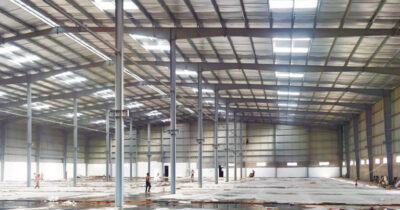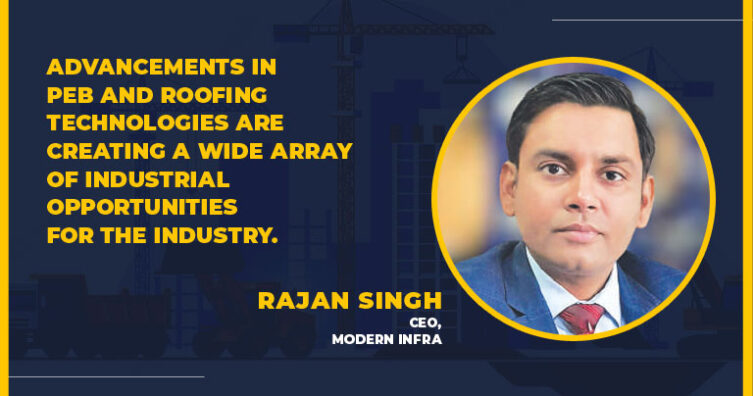Discussing the innovations and challenges in the PEB and roofing business, Rajan Singh, CEO of Modern Infra, emphasises the technologies empowering the value chain of PEB and roofing businesses.
What is the latest roofing and PEB advancements?
Design flexibility Standing seam roof systems available in tapered and curved sheets to fulfil the most challenging design criteria. Suitable for roofs with large spans. On-Site Roll-Forming Standing seam roof systems can be manufactured on-site using mobile roll-forming technology, which not only gives a single length from the ridge of the roof to the eave but also helps to make it a leak-proof structure with better control over the quality installation. Sleek, consistent.
Modern look Standing seam roof system is suitable for architectural applications because of its modern and clean look. In addition to the sleek, straight lines offered by this roof system, the roof can come in virtually any colour, including custom colours, to match any structure.
High design flexibility with multiple profile shapes makes it an architecturally superior roofing profile longevity metal roofs are already a long-lasting and low-maintenance roofing solution, especially compared to other roofing types. Since standing seam roofing comes with a concealed fix system which requires no piercing fasteners, there are no instances of damaging or loosening of fasteners or the roof surface. The standing seam roof system’s design flexibility, weather tightness and versatility make it an excellent choice for architecturally prominent buildings for commercial, industrial and warehouse applications.
How is the PEB industry progressing in terms of sustainability?
Pre-fabricated steel structures provide several advantages over traditional construction, including cheaper costs, sustainability, and flexibility. Steel-framed buildings are also more energy efficient than alternatives. When compared to on-site building, prefabrication dramatically reduces construction time. Compared to traditional on-site building, it takes less than half the time. Because of meticulous planning, the elimination of on-site weather conditions, and the simultaneous production of many assemblies, prefabrication reduces construction time. Shorter construction times allow us to take on multiple projects at once, allowing businesses to grow rather than rely on one project. Prefabrication is a new construction method that is becoming increasingly widespread. Some new concepts and practices in the construction sector boost productivity and save money. Prefabrication allows for time and cost savings, quality control and an environmentally responsible construction process.
What are the impacts of fluctuating prices on project quality and durability?
Steel price fluctuations are one of the PEB industry’s concerns. Steel contributes 60–70 percent of the total cost. Looking at the competition, the PEB companies take up projects, calculate the current steel prices, and pick up the orders. When the deal is finalised and the customers complete the site mobilisation, which takes a reasonably long time, the steel price shoots up. Now, the cost price of the raw material will be higher than the calculated price. This reduces the project’s profit or, in some cases, prolongs its losses. This is one of the biggest challenges a PEB company faces.

What are the challenges in matching the cost differences while catering to the sustainable and long-lasting demand for your products and service offerings?
Almost all industries in the world have been suffering from supply chain disruptions. All businesses—local, regional, national, or global—have faced unprecedented obstacles since early 2020. The metal fabrication industry is no exception.
Inflation: The price of everything continues to rise, from energy to raw materials. Borrowing becomes more expensive. Our operations must balance costs with prices to stay competitive. Managing costs while maintaining quality, revenue, and sales
Supply: Raw materials, parts, and most machines that come from overseas have encountered bottlenecks and delays. The cost of importing goods has risen significantly, and the uncertainty about supply has gotten so severe that we now face it.
Speed: Another of the biggest challenges we are facing is the production and delivery speed. Despite being aware of supply chain and cost challenges, customers were so used to timely manufacturing that they still demanded the exact turnaround times as before the pandemic. They want their project to be without delay.
How are increasing construction and infrastructure boosting the demand for sustainable designs in PEB?
These days the most emerging technology is 3D BIM (Building Information Modelling). TEKLA (3D BIM software) is quite a popular and emerging software in the industry. In the last two years, TEKLA has become an essential and potent tool for the PEB industry. For complex buildings/structures where other software is not adequate, TEKLA is filling the gap. Once the design is done, BIM software like TEKLA is used for modelling. All the problem areas associated with the industry are well handled using these technologies. It is faster compared with 2D detailing. Once the model is completed, it gives a list of raw materials, Shop floor drawings for fabrication, a dispatch list etc. 3D models can help minimise the errors associated with 2D drafting. BIM can be utilised to integrate services which are essential for large projects. In recent years new developments in BIM software have opened the gates for the PEB industry to embrace these new technologies.
For more details visit: https://moderninfra.co.in/
Cookie Consent
We use cookies to personalize your experience. By continuing to visit this website you agree to our Terms & Conditions, Privacy Policy and Cookie Policy.


















